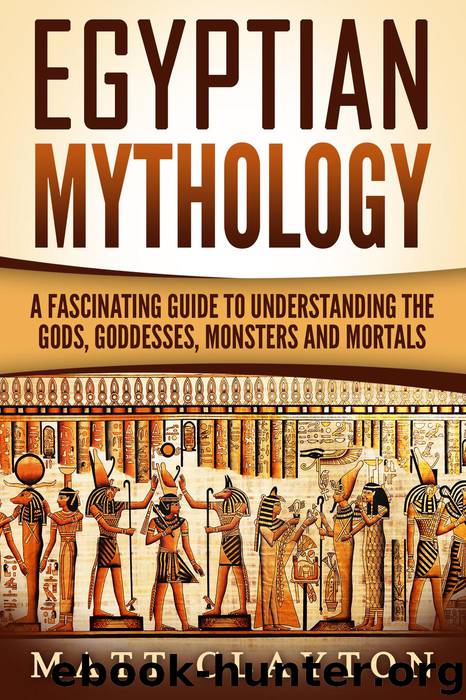Egyptian Mythology A Fascinating Guide to Understanding the Gods, Goddesses, Monsters, and Mortals (Greek Mythology - Norse Mythology - Egyptian Mythology) by Matt Clayton

Author:Matt Clayton [Clayton, Matt]
Language: eng
Format: epub
Tags: Egyptian Mythology, Norse Mythology, Matt Clayton, History, Greek Mythology
Publisher: Matt Clayton
Published: 2017-06-22T03:00:00+00:00
Chapter 8 — Ramesses the Great
All of Egyptian history seemed to lead up to the great Ozymandias—Ramesses II (c1303–1213 BC). Everything which came after him did not measure up to his stature. He was the King of Kings—the one about whom the poet would write, some 3,000 years later: “Look on my Works, ye Mighty, and despair!” Yet, his power eventually crumbled to dust.
Ramesses II’s father, Seti I, reclaimed much of the territory lost under Akhenaten. He had even taken back Kadesh (a town in Syria) and the region of Amurru, both conquered decades before by the Hittites. But the Egyptians under Seti once again lost Kadesh, because it was so close to the Hittite homelands and not easily controlled from the Egyptian capital.
In his second year on the throne, Ramesses II (reign 1279–1213 BC) was faced with a threat to commerce from the Sherden sea pirates. Other nations had been sending ships rich with cargo to Egypt for trade, but the pirates saw this as an opportunity for easy prosperity. The king placed ships and troops all along the Egyptian coast at strategic locations. He used merchant ships as bait, but each was filled with soldiers. The pirates took the bait and suffered their own enslavement.
Ramesses retook Amurru from the Hittites during his fourth year.
The king built a new capital city of Pi-Ramesses and included factories which would manufacture the tools of war—chariots, swords, shields, and more.
During his seventh year, Ramesses returned to the North to battle the Hittites once again. Though his campaign proved successful, Kadesh and Amurru were soon returned to Hittite control. In the tenth year, Ramesses attempted once again to reclaim that northern territory, but failed.
Relations between the two countries remained uneasy for several years thereafter.
Mursili III ruled the Hittite Empire from 1272–1265 BC, but was deposed by his uncle, Hattusili III, because of the younger man’s lack of skill and the fact that he let the Assyrians capture their huge territory of Hanigalbat (Mittani). At first Mursili III attempted to regain the throne, but failed. When all hope for him looked lost, he fled to the one place no Hittite would ever go—Egypt.
Hattusili III discovered that Mursili III had gone to Egypt and sent word to the court of Ramesses demanding that his nephew be returned to Hatti. The Egyptian pharaoh denied any knowledge of Mursili III’s presence in the lands of the Nile. The Hittite king did not believe Ramesses and threatened war.
In the year 1258 BC—Ramesses’ 21st year—both kings agreed to draw up a peace treaty. Neither side seemed well equipped to pursue a perpetual war over Kadesh, and neither side was willing merely to walk away from the city or its surrounding territory.
The World’s First Known Peace Treaty
A tall, middle-aged man crossed the room and looked down at the table where the grand vizier stood. The vizier indicated the scroll on the table and bowed his head to the one who had approached. This was no ordinary man of 45 years. He was trim, with a bearing of confidence and power.
Download
This site does not store any files on its server. We only index and link to content provided by other sites. Please contact the content providers to delete copyright contents if any and email us, we'll remove relevant links or contents immediately.
| Africa | Americas |
| Arctic & Antarctica | Asia |
| Australia & Oceania | Europe |
| Middle East | Russia |
| United States | World |
| Ancient Civilizations | Military |
| Historical Study & Educational Resources |
The Daily Stoic by Holiday Ryan & Hanselman Stephen(2708)
The Fate of Rome: Climate, Disease, and the End of an Empire (The Princeton History of the Ancient World) by Kyle Harper(2436)
People of the Earth: An Introduction to World Prehistory by Dr. Brian Fagan & Nadia Durrani(2346)
Ancient Worlds by Michael Scott(2102)
Babylon's Ark by Lawrence Anthony(2070)
Foreign Devils on the Silk Road: The Search for the Lost Treasures of Central Asia by Peter Hopkirk(2056)
India's Ancient Past by R.S. Sharma(1987)
MOSES THE EGYPTIAN by Jan Assmann(1972)
The Complete Dead Sea Scrolls in English (7th Edition) (Penguin Classics) by Geza Vermes(1840)
Lost Technologies of Ancient Egypt by Christopher Dunn(1797)
The Daily Stoic by Ryan Holiday & Stephen Hanselman(1768)
The Earth Chronicles Handbook by Zecharia Sitchin(1744)
24 Hours in Ancient Rome by Philip Matyszak(1676)
Alexander the Great by Philip Freeman(1646)
Aztec by Gary Jennings(1545)
The Nine Waves of Creation by Carl Johan Calleman(1520)
Curse Tablets and Binding Spells from the Ancient World by Gager John G.;(1510)
Before Atlantis by Frank Joseph(1483)
Earthmare: The Lost Book of Wars by Cergat(1466)
